At Last, The Wind

To put yourself in a fitting state of mind to consume what follows you may like to listen to any of, and simply the opening track will do, MGMT’s Oracular Spectacular, Manu Chao’s Clandestino and Damien Lewis’ Mission Creep: these have been what I’ve been listening to whilst riding since I’ve been alone.
I confess. I didn’t mean to. Please forgive me, Father, for I have joined the ranks of cycling hipsterdom and acquired an AeroPress. My individuality has been sacrificed upon the altar of better coffee. But I do not repent. It was the Mexican that gave me the holy Ecuadorean coffee in the Chilean hostel at the end of the world. It’s she that done it. It’s she that gone put the final nail in the coffin of my cowboy coffee prep - boiling and straining with a coarse sieve.
This is Punta Arenas, self-proclaimed “Gateway of Antarctica”, competing with the Argentine Ushuaia. There are two researchers staying in this hostel: she is a climate physicist and he is some kind of engineer, specialising in albedo effects on weather balloons or something. Malena is, I think, Dutch, but strangely for once the first question wasn’t, “De donde eres?” and equally strangely we have exchanged names: it’s her first time heading to Antarctica. He’s Venezuelan and I have no clue what his name is and neither he mine but he knows, “Soy de Londres.” And he’s visited Antarctica nine times already, attached to various countries’ bases - Chilean, Argentine and Russian - and of those nine times twice the flight has been delayed. This is the worst delay he’s experienced. They were due to fly Monday lunchtime and it’s Wednesday and they’re still here.
It’s a super hostel this. I’m not sure I want to share the name because I want to come back and I don’t want it to be inundated. I arrived Sunday early evening via an ice cream shop 3km out on the main avenue in, to charge devices and check messages from the Aussies. That was a good ice cream: cappuccino and rum & raisin, don’t hate. The Aussies were visiting the penguins on Isla Magdalena: they’re small penguins, not Jackass but Megallanic, a name that sonically makes them sound jacked. (Today they visited a King penguin colony on the way to Ushuaia from Porvenir, a ferry ride east from here.) They weren’t going to be back until 8, so I had time before we’d meet for dinner on Plaza de Armas and sink Cathedrals of Pisco Sour. iOverlander is the bible for South American wanderers. I tried a central hostel pinned on its map. The curtains were drawn and the doors firmly shut but a bare bulb hung alight inside so I tried the timbre and then the door, and waited. It’s cold out. Today I think it’s 8 Celsius. But the Sun shines bright and long into the evening casting a low glow across the single storey frontages, bouncing off pastel colours and other tones. There’s a certain stillness despite the fecking wind. (We’re allowed to say “fecking” now that Cillian Murphy did in his Golden Globes’ Best Actor acceptance speech and it wasn’t bleeped out.) There was another good sounding hostel around the corner. I asked if a “habitación compartido esta libre” and was quoted CLP 15,000 - I work on the simple basis of £1 being CLP 1,000 which isn’t quite right, this was about £13 - and I looked quizzical and asked “Sabes si hay un lugar central para acampar?” Amused but kind she asks if I’m looking for somewhere cheaper. I reconsider. And boy was that a lucky call. I lord it up in The West Wing. For the next three nights I’m the sole occupant of the corridor. The kitchen is bright and airy. The washing machine is freely available and clothes dry fast on the line in the gusts and Sun. And I buy an AeroPress.
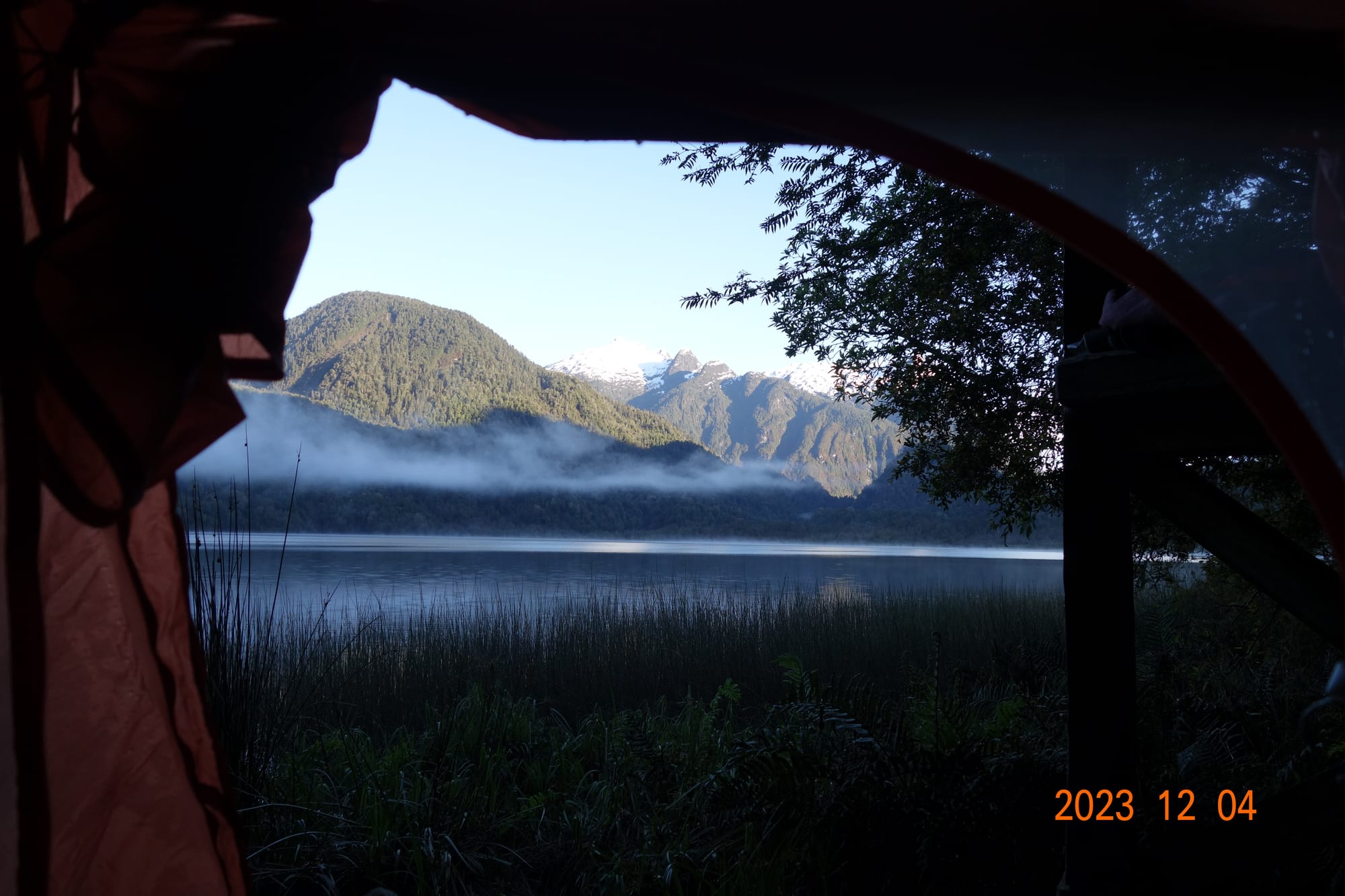
Patagonia. I have one. A nano puff that can pack into itself, much like the Alpkit Cloud Cover down throw that ordinarily I use as my pillow but wonderfully doubles up as a cold night extra either in The North Face sleeping bag I love (it’s orange: crème brûlée if you will, but please not American cheese) or wrapped around its exterior. That’s some gear chat for you.
Patagonia is also a huge land area, roughly and variously defined as anything south of the Rio Colorado or Rio Negro in Argentina, and something in Chile which I’m going to say is anything from Puerto Montt south. Windswept plains, choppy seas, the third and fourth largest ice fields on Earth (behind Antarctica and Greenland), Condors, tin roofs, Welsh. If you travelled down the Ruta 40 in Argentina you’d go mad; if you travelled up the Ruta 40 you’d go madder. And if you opt for the Pinochet-era built Carretera Austral, you’re in paradise (but best to forget good food). Pinochet has been described by a Chilean we stayed with as “our Hitler,” which is perhaps overcooking it but yes there was a junta, as there was in Argentina around the same time, and a great deal of repression and extrajudicial dealings: murders and the like. (On the BA flight to Santiago I woke up over the Uyuni salt flats and watched Argentina 1985; sadly the plane landed before the finale. It concerns the civil trial of the Argentine military leadership. Since you’re asking, the first film I watched before sleeping was the latest Indiana Jones; I needed something mindless and it delivered.)
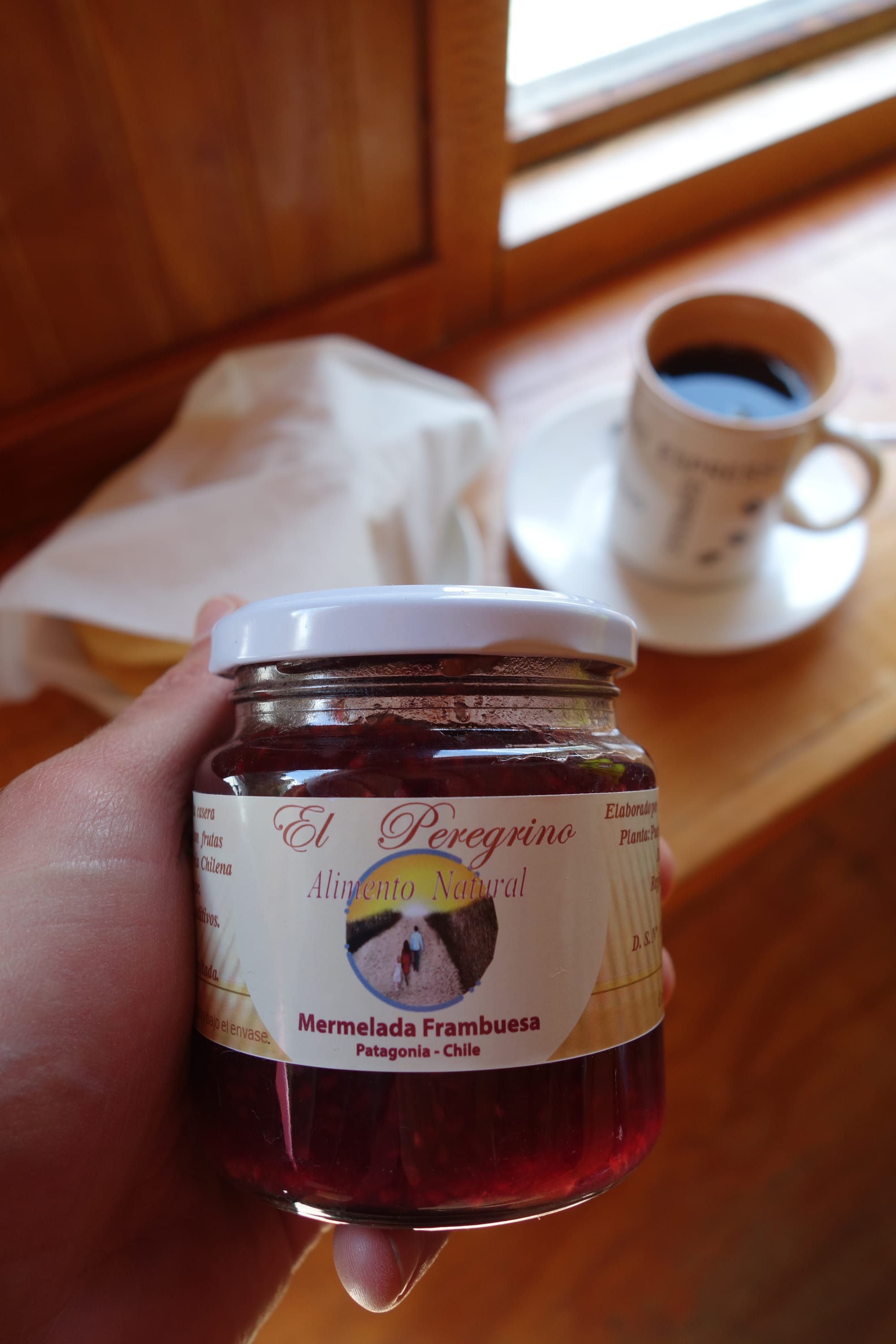
Arriving in Puerto Montt towards the end of November we were early onto the Carretera. Not that we started on it. We, Rosie and I, had a fortunate break. Rolling out Wednesday midday we headed to the post office to send some kit home. (Some of MY kit: I had too much!) We were going to cycle north to Puerto Varas but missed the turning and found ourselves whizzing along the coast on the Carretera. “Why don’t we just go?” We could figure out fuel and food shopping later. “Yeah?!” “Yeah?” “Yeah.” We passed a bike shop and backtracked. Rosie needed some inner tubes as we had different sized wheels. It wouldn’t open for another 20 minutes so we grabbed some empanadas from a nearby kiosk and sat outside. We reconsidered. And ended up on the 120km-adding Puerto Varas - Cochamo loop. We found all we needed in Varas and that night we asked a resident along the lakeside east of there if we could camp in his garden, a good and early first. It was the best introduction to our cycling together. We even experienced some early and unexpected gravel, two long stretches from Cochamo back west. We didn’t, however, see any volcanoes as they were hidden by cloud.
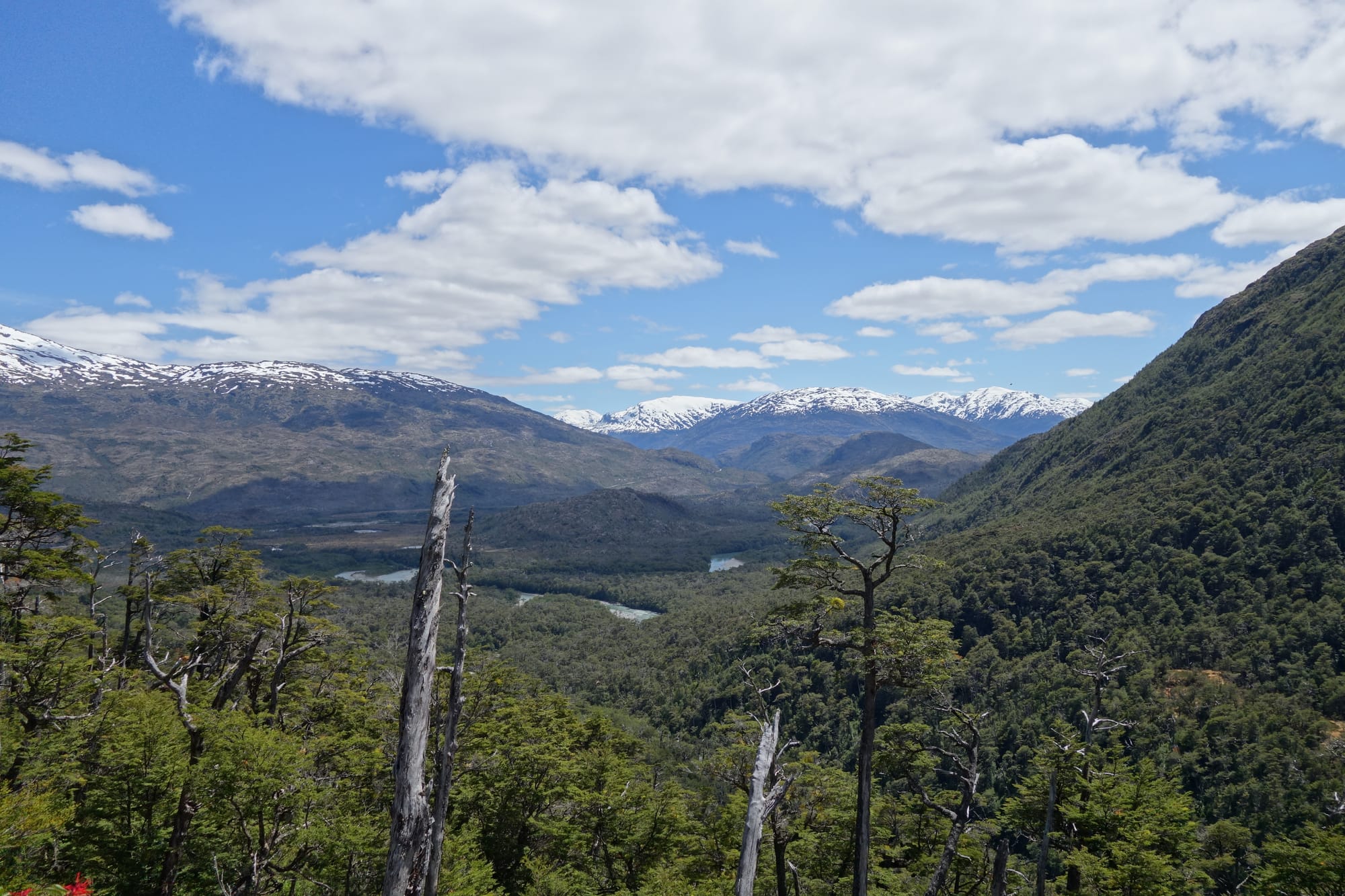
Everywhere we went we were told the season hadn’t begun, that it’s January and February, maybe a little December, a little March. It blew our minds. Here we were in beautiful weather and pristine landscapes and the campsites were closed. It suited us fine. The campsites would have us and there are more than enough “wild camping” spots despite the land largely being private and aggressively fenced.
We could also largely enjoy empty roads. Only in Caleta Puelche did we encounter our first cyclist, an American retired to Chiloe, the island south-west of Puerto Montt home to scary stories of male witchcraft and its iniation routine. His face shows sun and wind damage and he’s clearly arthritic. But he chugs away and we’ll see him each of the next few days until we pull away. Oftentimes he’s walking his blue bike with the sheepskin seat cover up a steep slope. He’s the first to warn us, baring his discoloured dentures, that these are nothing compared to the passes further south. I avoid using my lowest gear and nickname him “L’Americain”.
What passes? The more local the knowledge the less inclined you become to believe it. If you ask anyone in Cochrane about resupply options until the end of the road in Villa O’Higgins you’ll be told that there is nothing. It’s like no knowledge is their knowledge. Nothing? Bullshit. Tortel has plenty. We’re simple souls, cycle tourists. Porridge oats, peanut butter and an endless supply of assorted biscuits and chocolate are our currency. We trade for free. We accept and we give. Water is easy. It falls off the mountain side. These are your Alps and this is your Evian. Maybe avoid collecting from the stream that’s flowed through fields of cattle before hitting the road. Why risk it when round the bend you’ll be back up against a steep wall of rock with snowmelt tumbling down in a series of miniature waterfalls?
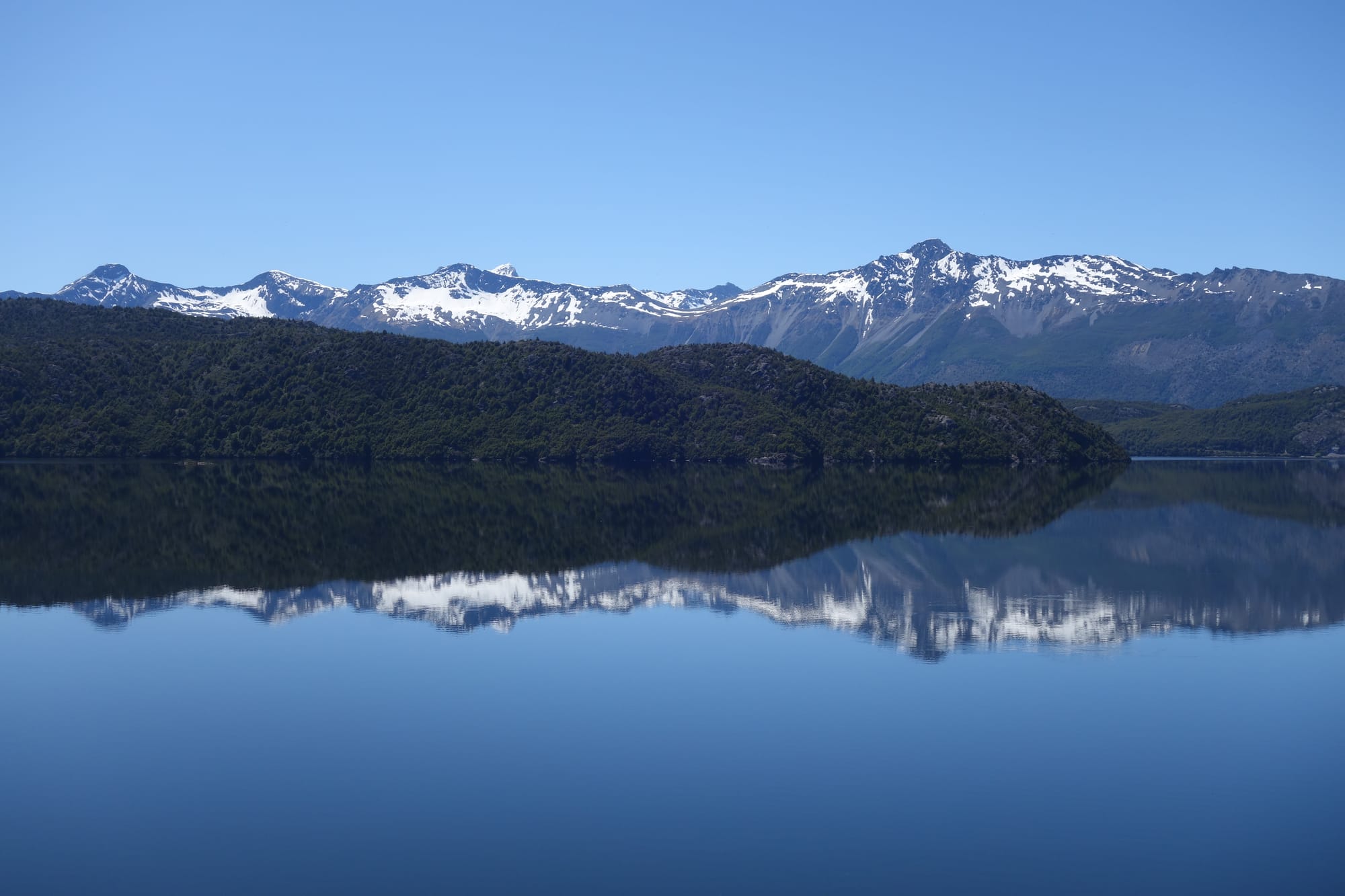
The biggest local lie we heard? That Chile Chico rests in a microclimate and is surrounded by cherry orchards and vineyards. We caught the 8pm ferry from Puerto Ibanez across Chile’s most important lake, Lago General Carrera (which also has an Argentine name since it straddles the border, a borde that our commuter boat precariously toed as it choked on its fumes), checking out of the Carretera for a couple days to visit their Babylon. It does not exist. What does exist is the gravelly fucker of a road that is the CH-265. And a fat as hell Westerly headwind. “You came to Chile Chico? You stay.”
It is a stupidly, scarily dramatic road. If you pumped The Highlands full of Miracle Gro and fed them an ocean’s worth of steroids you’d be nowhere close to replicating this monstrosity. You could rewind the tectonic plates until times when The Grampians were young and stood tall and you’d hit that facepalm emoji - failed again. It’s grim. It’s beautiful. So we hitch-hiked and watched the landscape unfurl at 30kph instead of 5.
We hitched a ride one more time. Tortel sits out on a limb, a 20km limb of gravel that’s lumpy and deep. The road is flat and makes you a sucker. You’ve been following this same river since Cochrane - although mysteriously it appeared to confuse upstream and downstream at times - and it’s swollen to a grand width and you have some funky weather pattern that’s seen you finally escape the rain but continue to have its curtain right there next to you, and all you’re thinking is, “Is this worth it?” (Is this the grown-up version of the whiny “Are we nearly there yet?”) It’s worth it. It’s a town on stilts on the edge of civilisation. It’s touristy, sure. Not really. Tortel doesn’t understand or doesn’t want or doesn’t care for its touristic value. A ferry arrives once a week having sailed out of Puerto Natales through the archipelago over 40 hours with its passengers well fed but poorly slept in vaguely reclinable seats. The passengers disembark around 8am and search forlornly for coffee and breakfast. Good luck, for nothing opens before 10. We hitched a ride out.
El Chalten was a godsend for Christmas. We arrived off the back of a two-day crossing deserving of its own write-up but I think you’ll find it’s been done to death. That said, the reaction as we climbed the farm track towards the border, as we rounded a bend, the woodland framing the scene, was priceless. I’m not sure words were really said, shouted, whooped or otherwise. But each of us in turn as we sent our eyes forwards to that space where the earth road met the blue sky, green trees on each side, made a noise. El Chalten is the Teheulche name, “Smoking Mountain”: it’s an industrial cloud chimney. Perito Moreno (who himself has a glaciar) named it Mt Fitz Roy after Darwin’s Beagle’s captain. Its cousin peak is named Poincenot after the French climber that died descending after the first successful summitting of Fitz Roy. It looks fake. It’s been green-screened into place. It appears to have demanded its own Wes Anderson sub-palate. And it’s awesome.
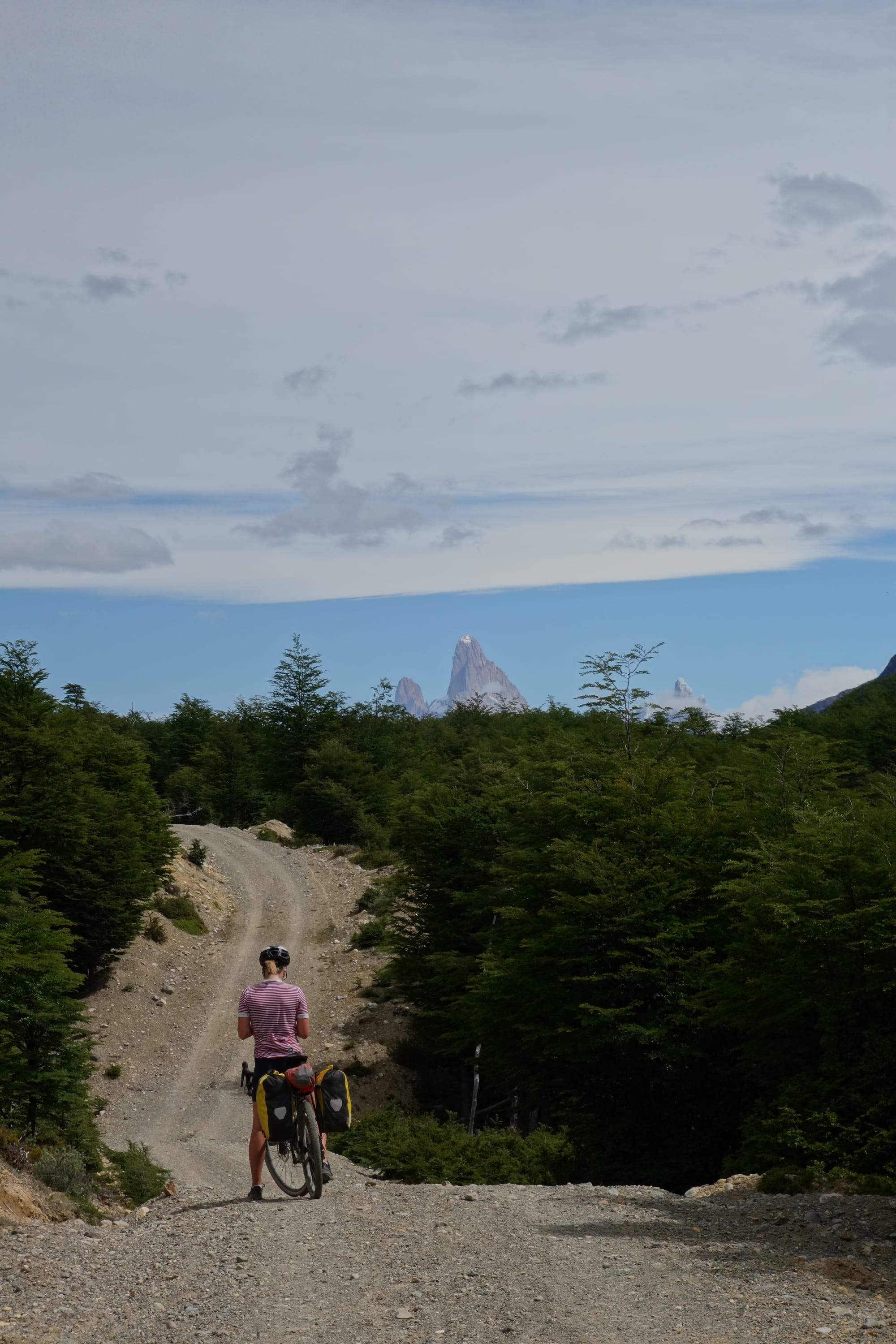
I digress. El Chalten marks the end of the gravel. The first building on the right is a panaderia and French Tom dives in. “He always does this.” He returns with something other than circular, semi-stale, hole-punched white bread. They’re pastry cones filled with dulce and capped with dark chocolate. We’re going to eat well.
A week later we leave, aiming for El Calafate for New Year’s Eve two days later. Patagonia. Windswept plains. At last, the wind. It’ll push us east and sometimes south too. It’s a big hand at your back. And we’re headed south-east out of El Chalten.
Pampas and guanaco. Down the Carretera Austral we’d cycled through The Alps, Yosemite, The Highlands, The Grand Canyon and more. There’d be colour and contour. And now we have the punchline to a joke. To the horizon it’s brown and above it’s blue. A two-tone hell. A strangely detailed sketch of a guanaco sits inside many a yellow triangle signpost. And many guanaco straddle the barbed-wire fences that run alongside. Dead. We lose count of the dead before we see our first live specimen. Standing still they have a dignified elegance. And then they move and you giggle. It’s a stumpier, furrier, both more and less exotic, galloping giraffe. It’s not quite elegance is it? We see one approach the fencing. And? It hurdles it. Successfully. No animals were hurt in the writing of this. It hurdles? Yeah that doesn’t bode well considering many an Olympic finalist topples at least a fence. The odds aren’t the best.
The road takes a 90 degree turn and boom, you’re cycling into a battering ram. Forecasts say funny things. “20kph W with 65kph gusts” means 65: it’s gusting the whole time, don’t be fooled. Rosie climbs off and lies face down in the shoulder’s gravel. We limp to La Leona, the only place selling anything between El Chalten and El Calafate, 200km of nothing. Leona is a female puma and this estancia is named so for the leona that attacked Perito Moreno here when he was journeying to Chalten. It’s also known for having unwittingly played host to Butch Cassidy and The Sundance Kid in the aftermath of their robbing a bank in Rio Gallegos. So it has info on the walls and a museum within. Rosie has a nap. She’s been ill since halfway round the 4-day El Huemel trail: a hike that includes two ziplines, a glaciar crossing, two you-can-fly passes (one is simply called Paso del Viento, Pass of The Wind, original), and ummmm The Southern Ice Field which is bonkers in its hugeness that some off-World JCB has driven dirty tracks through.
The next day Rosie wisely hitches a ride to avoid the run-in to El Calafate that is a due West, headwind-killer 32km. Within a kilometre all moisture has been whipped out of me. Rosie is ill and I’ve just killed myself. We’re halfway through The Alpinist when corks pop outside. Happy new year, Wind.
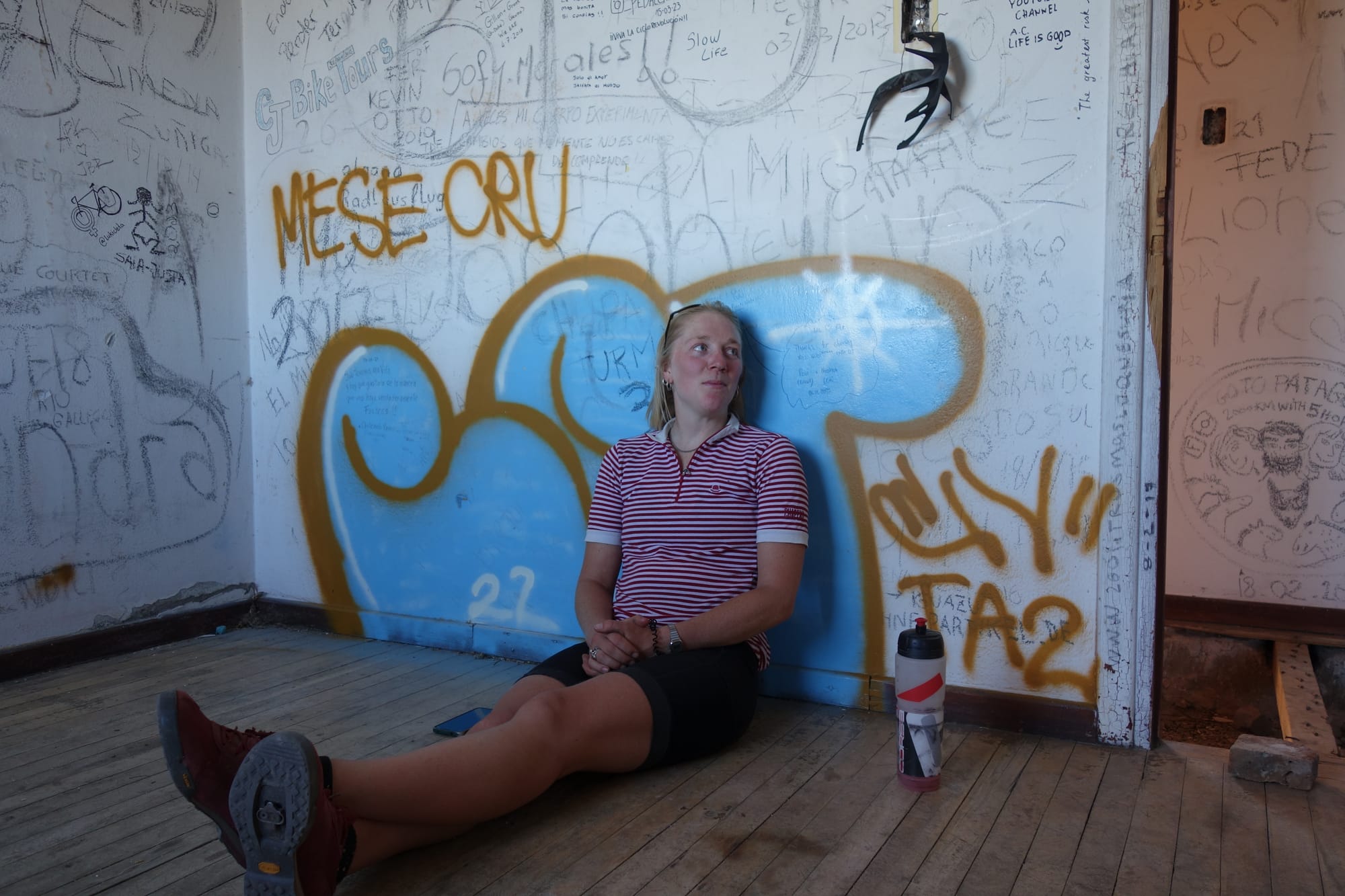
To close out, have a listen to Zach Bryan’s eponymous album. Preferably in a quiet space. Zach Bryan was recommended, by way of my best friend Rufus attending his Tour Divide film premiere in London, by no less than Lachlan Morton: Rufus had asked him what he listens to whilst cycling long distance or, rather, what he’d recommend to someone riding long distance, and Zach Bryan was the singular response. It’s good.